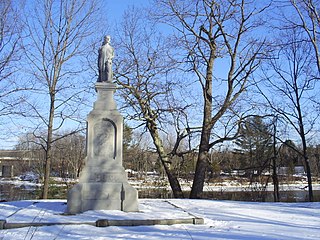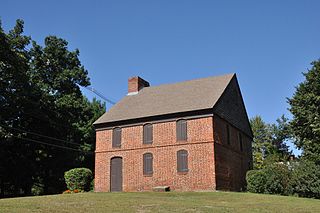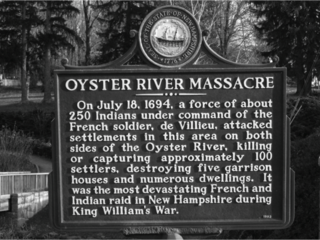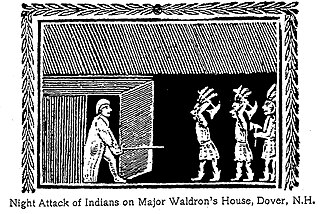
Cotton Mather was a Puritan clergyman and author in colonial New England, who wrote extensively on theological, historical, and scientific subjects. After being educated at Harvard College, he joined his father Increase as minister of the Congregationalist Old North Meeting House in Boston, Massachusetts, where he preached for the rest of his life. He has been referred to as the "first American Evangelical".

The Abenaki are Indigenous people of the Northeastern Woodlands of Canada and the United States. They are an Algonquian-speaking people and part of the Wabanaki Confederacy. The Eastern Abenaki language was predominantly spoken in Maine, while the Western Abenaki language was spoken in Quebec, Vermont, and New Hampshire.

Queen Anne's War (1702–1713) was the second in a series of French and Indian Wars fought in North America involving the colonial empires of Great Britain, France, and Spain; it took place during the reign of Anne, Queen of Great Britain. In the United States, it is regarded as a standalone conflict under this name. Elsewhere it is usually viewed as the American theater of the War of the Spanish Succession. It is also known as the Third Indian War. In France it was known as the Second Intercolonial War.

Boscawen is a town in Merrimack County, New Hampshire, United States. The population was 3,998 at the 2020 census.

Hannah Duston was a colonial Massachusetts Puritan woman who was taken captive by Abenaki people from Quebec during King William's War, with her first newborn daughter, during the 1697 raid on Haverhill, in which 27 colonists, 15 of them children, were killed. In her account she stated that the Abenakis killed her newborn baby soon after they were captured. While detained on an island in the Merrimack River in present-day Boscawen, New Hampshire, she killed and scalped ten of the Abenaki family members holding them hostage, with the assistance of two other captives.

Magnalia Christi Americana is a book published in 1702 by the puritan minister Cotton Mather (1663–1728). Its title is in Latin, but its subtitle is in English: The Ecclesiastical History of New England from Its First Planting in 1620, until the Year of Our Lord 1698. It was generally written in English and printed in London "for Thomas Parkhurst, at the Bible and Three Crowns, Cheapside."

Dummer's War (1722–1725) was a series of battles between the New England Colonies and the Wabanaki Confederacy, who were allied with New France. The eastern theater of the war was located primarily along the border between New England and Acadia in Maine, as well as in Nova Scotia; the western theater was located in northern Massachusetts and Vermont in the frontier areas between Canada and New England.

The Raid on Deerfield, also known as the Deerfield Massacre, occurred during Queen Anne's War on February 29, 1704, when French and Native American raiders under the command of Jean-Baptiste Hertel de Rouville attacked the English colonial settlement of Deerfield, Massachusetts Bay, just before dawn. They burned parts of the town and killed 47 colonists. The raiders left with 112 colonists as captives, whom they took overland the nearly 300 miles to Montreal; some died or were killed along the way because they were unable to keep up. Roughly 60 colonists were later ransomed by their associates, while others were adopted by Mohawk families at Kahnawake and became assimilated into the tribe. In this period, English colonists and their Indian allies were involved in similar raids against French villages along the northern area between the spheres of influence.
John Lovewell was a militia captain who fought during Father Rale's War. He lived in present-day Nashua, New Hampshire. He led three expeditions against the Abenaki Indians. Lovewell became one of the most famous rangers of the 18th century.

Captivity narratives are usually stories of people captured by enemies whom they consider uncivilized, or whose beliefs and customs they oppose. The best-known captivity narratives in North America are those concerning Europeans and Americans taken as captives and held by the indigenous peoples of North America. These narratives have had an enduring place in literature, history, ethnography, and the study of Native peoples.

The Dustin-Duston Garrison House or Dustin House is a historic First Period house in Haverhill, Massachusetts. Built about 1700, it is one of a very small number of surviving period houses built out of brick in Massachusetts. It is also notable for its association with the Dustin or Duston family; Hannah Duston was famously captured by Native Americans during a 1697 attack on Haverhill, probably while this house was under construction. The house was added to the National Register of Historic Places in 1990.

John Williams was a New England Puritan minister who was the noted pastor of Deerfield from 1688 to his death. He and most of his family were taken captive in the Raid on Deerfield in 1704 during Queen Anne's War. He was held by the French in Montreal for more than two years, who wanted a high-ranking French pirate in exchange. After being released in late 1706, Williams became even more notable for The Redeemed Captive (1707), his account of his captivity. It became a well-known work in the genre of captivity narratives.

The Raid on Haverhill was a military engagement that took place on August 29, 1708, during Queen Anne's War. French, Algonquin, and Abenaki warriors under the command of Jean-Baptiste Hertel de Rouville descended on Haverhill, then a small frontier community in the Province of Massachusetts Bay. In the surprise attack, 16 people were killed and another 14 to 24 were taken captive. A rapid militia muster gave chase, and in a skirmish later in the day, nine of the French and Indian party were killed and some of their prisoners escaped.

The Raid on Oyster River, also known as the Oyster River Massacre, happened during King William's War, on July 18, 1694, when a group of Abenaki and some Maliseet, directed by the French, attacked an English settlement at present-day Durham, New Hampshire.

The Raid on Dover took place in Dover, New Hampshire, on June 27–28, 1689. Led by Chief Kancamagus of the Pennacook, it was part of King William's War, the North American theater of the Nine Years' War (1688–1697), fought between England and France and their respective Native allies.
The Northeast Coast campaign was the first major campaign by the French of Queen Anne's War in New England. Alexandre Leneuf de La Vallière de Beaubassin led 500 troops made up of French colonial forces and the Wabanaki Confederacy of Acadia. They attacked English settlements on the coast of present-day Maine between Wells and Casco Bay, burning more than 15 leagues of New England country and killing or capturing more than 150 people. The English colonists protected some of their settlements, but a number of others were destroyed and abandoned. Historian Samuel Drake reported that, "Maine had nearly received her death-blow" as a result of the campaign.
The Raid on Groton happened during King William's War, on July 27, 1694, at Groton, Massachusetts. This was one of numerous attacks against the settlement in the late 17th and early 18th centuries. The village had been raided during King Philip's War and temporarily abandoned by numerous families. It was also raided in June 1707 during Queen Anne's War.
The First Abenaki War was fought along the New England/Acadia border primarily in present-day Maine. Richard Waldron and Charles Frost led the forces in the northern region, while Jean-Vincent d'Abbadie de Saint-Castin worked with the tribes that would make up the Wabanaki Confederacy. The natives engaged in annual campaigns against the English settlements in 1675, 1676, and 1677. Waldron sent forces so far north that he attacked the Mi'kmaq in Acadia.

Colonel Johnson Harmon was an army officer in colonial America. He led the expedition during Father Rale's War that killed Father Sébastien Rale in the Battle of Norridgewock. Harmon was heralded as a hero upon his return to Boston. New England Officer and historian Samuel Penahallow proclaimed the attack was "the greatest victory we have obtained in the three or four last wars."
Hannah Swarton, née Joana Hibbert/Hibbard, was a New England colonial pioneer who was captured by Abenaki Indians and held prisoner for 5+1⁄2 years, first in an Abenaki community and later in the home of a French family in Quebec. She was eventually freed and told her story to Cotton Mather, who used it as a moral lesson in several of his works.














